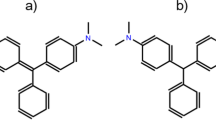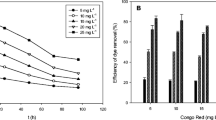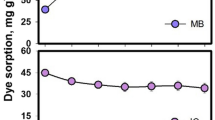Abstract
Dyes are used in many applications with their consequent discharge into aquatic environments. Alternative methods of pollutant removal, such as biosorption, are currently necessary to achieve an efficient, low-cost, and environmentally friendly process. The biomasses, living and dead, from the microalga Phaeodactylum tricornutum were studied to determine their ability to remove three dyes, Methylene Blue, Crystal Violet and Safranin from seawater. The removal properties were determined as a function of contact time, initial dye concentrations, and pH, and characterized with the determination of the point of zero charge (pHPZC) and FTIR. The highest removal capacity was obtained with crystal violet (66.4 mg g−1), without significant differences between both biomasses and following a pseudo-fourth order kinetics, indicating a high affinity for said dye. Maximum removal capacity for methylene blue was 18.9 mg g−1 with significant differences between both biomasses until the concentration of 10 mg L−1, the dead biomass being more effective since this dye would present difficulties to enter the living cells. The kinetics was of pseudo-third order. Safranin obtained a removal capacity of 19.6 mg g−1 with also significant differences between both biomasses up to a concentration < 10 mg L−1, but with living biomass being more effective and a sigmoidal kinetics, indicating that this dye would more easily enter living cells. Photodegradation of these dyes and isotherms were also analyzed to properly characterize the process. The results demonstrated that the biomass of P. tricornutum eliminated efficiently these dyes from a solution with high ionic load (seawater).







Similar content being viewed by others
Data availability
The datasets generated during and/or analyzed during the current study are available from the corresponding author on reasonable request.
References
Ahmad R (2009) Studies on adsorption of crystal violet dye from aqueous solution onto coniferous pinus bark powder (CPBP). J Hazard Mater 171:767–773
AitAhsaine H, Zbair M, Anfar Z, Naciri Y, El haouti R, El Alem N, Ezahri M (2018) Cationic dyes adsorption onto high surface area ‘almond shell’ activated carbon: Kinetics, equilibrium isotherms and surface statistical modeling. Mater Today Chem 8:121–132
Albadarin AB, Mangwandi C (2015) Mechanisms of Alizarin Red S and Methylene Blue biosorption onto olive stone by-product: Isotherm study in single and binary systems. J Env Manage 164:86–93
Ali H, Muhammad S (2008) Biosorption of Crystal Violet from water on leaf biomass of Calotropis procera. Environ Sci Technol 1:143–150
Asgher M (2012) Biosorption of reactive dyes: A review. Water Air Soil Pollut 223:2417–2435
Banat I, Nigam P, Singh D, Marchant R (1996) Microbial decolorization of textile-dye-containing effluents: a review. Bioresour Technol 58:217–227
Bhattacharyya K, Sharma A (2005) Kinetics and thermodynamics of methylene blue adsorption on neem (Azadirachta indica) leaf powder. Dyes Pigments 65:51–59
Bouraada M, Lafjah M, Ouali MS, de Menorval LC (2008) Basic dye removal from aqueous solutions by dodecylsulfate- and dodecyl benzene sulfonate-intercalated hydrotalcite. J Hazard Mater 153:911–918
Bouzikri S, Ouasfi N, Benzidia N, Salhi A, Bakkas S, Khamliche L (2020) Marine alga “Bifurcaria bifurcata”: biosorption of Reactive Blue 19 and methylene blue from aqueous solutions. Environ Sci Pollut Res Int 27:33636–33648
Caparkaya D, Cavas L (2008) Biosorption of methylene blue bya brown alga Cystoseira barbatula Kutzing. Acta Chim Slov 55:547–553
Chakrabarti S, Dutta B (2005) On the adsorption and diffusion of methylene blue in glass fibers. J Colloid Interf Sci 286:807–811
Chen CY, Chang JC, Chen AH (2011) Competitive biosorption of azo dyes from aqueous solution on the templated crosslinked-chitosan nanoparticles. J Hazard Mater 185:430–441
Chen C, Hu J, Wang J (2020) Biosorption of uranium by immobilized Saccharomyces cerevisiae. J Environ Radioact 213:106158
Chowdhury S, Das P (2011) Adsorption of crystal violet from aqueous solution onto NaOH-modified rice husk. Carbohyd Polym 86:1533–1541
Coelho CM, de Andrade JR, da Silva MGC, Vieira MGA (2020) Removal of propranolol hydrochloride by batch biosorption using remaining biomass of alginate extraction from Sargassum filipendula algae. Environ Sci Pollut Res Int 27:16599–16611
Daneshvar E, Zarrinmehr MJ, Hashtjin AM, Farhadian O, Bhatnagar A (2018) Versatile applications of freshwater and marine water microalgae in dairy wastewater treatment, lipid extraction and tetracycline biosorption. Bioresour Technol 268:523–530
de Araujo TP, Tavares FO, Vareschini DT, Barros M (2020) Biosorption mechanisms of cationic and anionic dyes in a low-cost residue from brewer’s spent grain. Environ Technol 1–16
de-Bashan LE, Bashan Y (2010) Immobilized microalgae for removing pollutants: Review of practical aspects. Bioresour Technol 101:1611–1627
El-Sikaily A, Khaled A, El Nemr A, Abdelwahab O (2006) Removal of methylene blue from aqueous solution by marine green alga Ulva lactuca. J Chem Ecol 22:149–157
El Haddad M, Slimani R, Rachid M, Rachid L, Rafqah S, Lazar S (2013) Evaluation of potential capability of calcined bones on the biosorption removal efficiency of safranin as cationic dye from aqueous solutions. J Taiwan Inst Chem E 44:13–18
Fomina M, Gadd GM (2014) Biosorption: current perspectives on concept, definition and application. Bioresour Technol 160:3–14
Franco DSP, Georgin J, Drumm FC, Netto MS, Allasia D, Oliveira MLS, Dotto GL (2020) Araticum (Annona crassiflora) seed powder (ASP) for the treatment of colored effluents by biosorption. Environ Sci Pollut Res Int 27:11184–11194
Gadd GM (2009) Biosorption: critical review of scientific rationale, environmental importance and significance for pollution treatment. J Chem Tech Biotechnol 84:13–28
Georgin J, Marques BS, Peres EC, Allasia D, Dotto GL (2018) Biosorption of cationic dyes by Para chestnut husk (Bertholletia excelsa). Water Sci Technol 77:1612–1621
Georgin J, Franco DSP, Netto MS, Allasia D, Oliveira MLS, Dotto GL (2020) Treatment of water containing methylene by biosorption using Brazilian berry seeds (Eugenia uniflora). Environ Sci Pollut Res Int 27:20831–20843
Grand View Research I (2017) Dyes & Pigments Market Analysis By Product [Dyes (Reactive, Vat, Acid, Direct, Disperse), Pigments (Organic, Inorganic)], By Application (Dyes, Pigments), And Segment Forecasts, 2018 - 2025. Grand View Research, Inc., Report Report ID: GVR-1–68038–545–8, p 130
Grassi P, Reis C, Drumm FC, Georgin J, Tonato D, Escudero LB, Kuhn R, Jahn SL, Dotto GL (2019) Biosorption of crystal violet dye using inactive biomass of the fungus Diaporthe schini. Water Sci Technol 79:709–717
Guler U, Ersan M, Tuncel E, Dügenci F (2015) Mono and simultaneous removal of crystal violet and safranin dyes from aqueous solutions by HDTMA-modified Spirulina sp. Process Saf Environ 99:194–206
Gurses A, Doğar Ç, Yalçin M, Açıkyıldız M, Bayrak R, Karaca S(2006) The Adsorption kinetics of the cationic dye, methylene blue, onto clay. J Hazard Mater 131:217–228
Gurusamy A, Juang R-S, Lee D-J (2002) Use of cellulose-based wastes for adsorption of dyes from aqueous solutions. J Hazard Mater 92:263–274
Herrero C, Cid A, Fábregas J, Abalde J (1991) Yields in biomass and chemical constituents of four commercially important marine microalgae with different culture media. Aquacult Eng 10:99–110
Huang H, Jia Q, Jing W, Dahms HU, Wang L (2020) Screening strains for microbial biosorption technology of cadmium. Chemosphere 251:126428
Işikver Y (2017) Removal of some cationic dyes from aqueous solution by acrylamide- or 2-hydroxyethyl methacrylate-based copolymeric hydrogels. Fiber Polym 18:2070–2078
Kaushik P, Malik A (2009) Fungal dye decolourization: Recent advances and future potential. Environ Int 35:127–141
Khattri S, Singh M (2000) Colour removal from synthetic dye waste water using a bioadsorbent. Water Air Soil Pollut 120:283–294
Kumar V, Sivanesan S (2005) Comparison of linear and non-linear method in estimating the sorption isotherm parameters for safranin onto activated carbon. J Hazard Mater 123:288–292
Kumar V, Ramamurthi V, Sivanesan S (2005) Modeling the mechanism involved during the sorption of Methylene Blue onto fly ash. J Colloid Interf Sci 284:14–21
Lebron YAR, Moreira VR, de Souza Santos LV (2021)Biosorption of methylene blue and eriochrome black T onto the brown macroalgae Fucus vesiculosus: equilibrium, kinetics, thermodynamics and optimization. Environ Technol 42:279–297
Lee KY, Lee SH, Lee JE, Lee SY (2019) Biosorption of radioactive cesium from contaminated water by microalgae Haematococcus pluvialis and Chlorella vulgaris. J Env Manage 233:83–88
Lellis B, Fávaro-Polonio CZ, Pamphile JA, Polonio JC (2019) Effects of textile dyes on health and the environment and bioremediation potential of living organisms. Biotechnol Res Innov 3:275–290
Madhavakrishnan S, Manickavasagam K, Vasanthakumar R, Rasappan K, Mohanraj R, Pattabhi S (2009) Adsorption of crystal violet dye from aqueous solution using Ricinus communis Pericarp carbon as an adsorbent. J Chem 6:1109–1116
Malarvizhi R, Ho Y-S (2010) The influence of pH and the structure of the dye molecules on adsorption isotherm modeling using activated carbon. Desalination 264:97–101
Malekbala M, Hosseini S, Yazdi S, Soltani S, MalekbalaM, (2012) The study of the potential capability of sugar beet pulp on the removal efficiency of two cationic dyes. Chem Eng Res Des 90:704–712
Mana M, Ouali MS, de Menorval LC (2007) Removal of basic dyes from aqueous solutions with a treated spent bleaching earth. J Colloid Interface Sci 307:9–16
Michalak I, Chojnacka K, Witek-Krowiak A (2013) State of the art for the biosorption process–a review. Appl Biochem Biotechnol 170:1389–1416
Parab H, Sudersanan M, Shenoy N, Pathare T, Vaze B (2009) Use of agro-industrial wastes for removal of basic dyes from aqueous solutions. Clean-Soil Air Water 37:963–969
Pathak VV, Kothari R, Chopra AK, Singh DP (2015) Experimental and kinetic studies for phycoremediation and dye removal by Chlorella pyrenoidosa from textile wastewater. J Environ Manage 163:270–277
Peng H, Li D, Ye J, Xu H, Xie W, Zhang Y, Wu M, Xu L, Liang Y, Liu W (2019) Biosorption behavior of the Ochrobactrum MT180101 on ionic copper and chelate copper. J Environ Manage 235:224–230
Priyadarshani I, Sahu D, Rath B (2011) Microalgal bioremediation: Current practices and perspectives. J Biochem Tech 3:299–304
Reddy S, Osborne JW (2020) Biodegradation and biosorption of Reactive Red 120 dye by immobilized Pseudomonas guariconensis: Kinetic and toxicity study. Water Environ Res. https://doi.org/10.1002/wer.1319
Rehman MSU, Kim I, Han J-I (2012) Adsorption ofmethylene blue dye from aqueous solution by sugar extracted spent rice biomass. Carbohydr Polym 90:1314–1322
Sabir JSM, Theriot EC, Manning SR, Al-Malki AL, Khiyami MA, Al-Ghamdi AK, Sabir MJ, Romanovicz DK, Hajrah NH, El Omri A, Jansen RK, Ashworth MP (2018) Phylogenetic analysis and a review of the history of the accidental phytoplankter, Phaeodactylum tricornutum Bohlin (Bacillariophyta). PLoS ONE 13(6):e0196744
Salem MA, Elsharkawy RG, Hablas MF (2016) Adsorption of brilliant green dye by polyaniline/silver nanocomposite: Kinetic, equilibrium, and thermodynamic studies. Eur Polym J 75:577–590
Sanghi R, Verma P (2013) Decolorisation of aqueous dye solutions by low-cost adsorbents: a review. Color Technol 129:85–108
Santaeufemia S, Torres E, Mera R, Abalde J (2016) Bioremediation of oxytetracycline in seawater by living and dead biomass of the microalga Phaeodactylum tricornutum. J Hazard Mater 320:315–325
Santaeufemia S, Torres E, Abalde J (2018) Biosorption of ibuprofen from aqueous solution using living and dead biomass of the microalga Phaeodactylum tricornutum. J Appl Phycol 30:471–482
Santaeufemia S, Abalde J, Torres E (2019) Eco-friendly rapid removal of triclosan from seawater using biomass of a microalgal species: Kinetic and equilibrium studies. J Hazard Mater 369:674–683
Sedlakova-Kadukova J, Kopcakova A, Gresakova L, Godany A, Pristas P (2019) Bioaccumulation and biosorption of zinc by a novel Streptomyces K11 strain isolated from highly alkaline aluminium brown mud disposal site. Ecotoxicol Environ Saf 167:204–211
Shariati S, Faraji M, Yamini Y, Rajabi A (2011) Fe3O4 magnetic nanoparticles modified with sodium dodecyl sulfate for removal of safranin O dye from aqueous solutions. Desalination 270:160–165
Sharma YC, Upadhyay S (2009) Removal of a cationic dye from wastewaters by adsorption on activated carbon developed from coconut coir. Energy Fuels 23:2983–2988
Shoueir K, El-Sheshtawy H, Misbah M, El-Hosainy H, El-Mehasseb I, El-Kemary M (2018) Fenton-like nanocatalyst for photodegradation of methylene blue under visible light activated by hybrid green DNSA@Chitosan@MnFe2O4. Carbohydr Polym 197:17–28
Silva F, Nascimento L, Brito M, da Silva K, Paschoal W Jr, Fujiyama R (2019) Biosorption of Methylene Blue dye using natural biosorbents made from weeds. Materials (Basel) 12(15):2486
Singh SN (ed) (2014) Microbial degradation of synthetic dyes in wastewaters. Environmental Science. Springer, Cham
Singh P, Iyengar L (2007) Bacterial decolorization and degradation of azo dyes. Int Biodeter Biodegr 59:73–84
Tabaraki R, Sadeghinejad N (2017) Biosorption of six basic and acidic dyes on brown alga Sargassum ilicifolium: optimization, kinetic and isotherm studies. Water Sci Technol 75:2631–2638
Tan IAW, Hameed B, Ahmad AL (2007) Equilibrium and kinetic studies on basic dye adsorption by oil palm fibre activated carbon. Chem Eng J 127:111–119
Torres E (2020) Biosorption: A review of the latest advances. Processes 8:1584–1607
Torres E, Cid A, Herrero C, Abalde J (1998) Removal of cadmium ions by the marine diatom Phaeodactylum tricornutum Bohlin accumulation and long-term kinetics of uptake. Bioresour Technol 63:213–220
Ubando AT, Africa ADM, Maniquiz-Redillas MC, Culaba AB, Chen WH, Chang JS (2020) Microalgal biosorption of heavy metals: A comprehensive bibliometric review. J Hazard Mater 402:123431
van der Zee FP, Villaverde S (2005) Combined anaerobic–aerobic treatment of azo dyes—A short review of bioreactor studies. Water Res 39:1425–1440
Weyermann C, Kirsch D, Vera CC, Spengler B (2009) Evaluation of the photodegradation of crystal violet upon light exposure by mass spectrometric and spectroscopic methods. J Forensic Sci 54:339–345
Xiong JQ, Kurade MB, Jeon BH (2018) Can microalgae remove pharmaceutical contaminants from water? Trends Biotechnol 36:30–44
Xu S, Xing Y, Liu S, Hao X, Chen W, Huang Q (2020) Characterization of Cd2+ biosorption by Pseudomonas sp. strain 375, a novel biosorbent isolated from soil polluted with heavy metals in Southern China. Chemosphere 240:124893
Yagub MT, Sen TK, Afroze S, Ang HM (2014) Dye and its removal from aqueous solution by adsorption: A review. Adv Colloid Interface Sci 209:172–184
Zhou Q, Gong WQ, Li YB, Chen SH, Yang DJ, Bai CP, Liu XF, Xu N (2011) Biosorption of Methylene Blue onto spent corncob substrate: kinetics, equilibrium and thermodynamic studies. Water Sci Technol 63:2775–2780
Zusková E, Máchová J, Svobodova Z, Vesely T (2007) Negative effects of malachite green and possibilities of its replacement in the treatment of fish eggs and fish: A review. Vet Med-Czech 52:527–539
Funding
This work was carried out with the financial support of the Spanish “Ministerio de Economía, Industria y Competitividad” (CTM2017-88668-R).
Author information
Authors and Affiliations
Corresponding author
Additional information
Publisher’s note
Springer Nature remains neutral with regard to jurisdictional claims in published maps and institutional affiliations.
Supplementary Information
Below is the link to the electronic supplementary material.
Rights and permissions
About this article
Cite this article
Santaeufemia, S., Abalde, J. & Torres, E. Efficient removal of dyes from seawater using as biosorbent the dead and living biomass of the microalga Phaeodactylum tricornutum: equilibrium and kinetics studies. J Appl Phycol 33, 3071–3090 (2021). https://doi.org/10.1007/s10811-021-02513-0
Received:
Revised:
Accepted:
Published:
Issue Date:
DOI: https://doi.org/10.1007/s10811-021-02513-0




